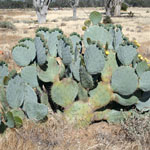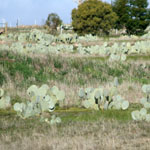Wheel cactus
Common name:
- Wheel cactus
Scientific name:
- Opuntia robusta H.L. Wendl. ex. Pfeiff.
Other common name:
- Wheel pear
Plant status
Catchment management authority boundaries
Regionally prohibited in the Port Phillip and Western Port catchments.
Regionally controlled in the Mallee, Wimmera, North Central and North East catchments.
Restricted in the Glenelg Hopkins, Goulburn Broken, West Gippsland, East Gippsland and Corangamite catchments.
Plant biology
Appearance
Shrub (or bush)
Description
An erect succulent shrub growing to 1 to 2m high.
Stems
Consist of a series of blue-green fleshy segments (also known as joints, pads or cladodes) which are commonly thought of as leaves but are really flattened stems.
Segments are circular growing, to 40cm in diameter — flat, glabrous and armed with tufts of numerous barbed bristles (glochids). Commonly found with 1 to 5 sharp spines growing to 4cm long arising from each areole.
Leaves
Small, scale-like, produced beneath the areoles on young segments only — which are shed as segments when mature.
Flowers
Yellow petals with reddish streaks on the back. Flowers are about 5 to 8cm in diameter, sessile, with a fleshy base, produced mostly on the upper margins of terminal segments.
Fruit
Pink to purple and barrel-shaped growing to 8cm long and 6cm in diameter, with dark red flesh bearing tufts of fine barbed hairs or bristles in areoles.
Roots
The root system of the wheel cactus is shallow and fibrous.
Growth and lifecycle
Method of reproduction and dispersal
The weed produces viable seed, which can be spread in the droppings of birds, foxes and other animals over large distances. The plant reproduces by seed and also propagates from branch segments.
Rate of growth and spread
Once established, individual wheel cactus plants can live for several decades.
Seedbank propagule persistence
Wheel cactus produces numerous fruits, with each fruit containing numerous seeds.
Preferred habitat
Wheel cactus prefers arid and semi-arid areas in warm temperate and sub-tropical regions, where it grows well on shallow granite soils. The plant is drought-resistant.
Distribution
It has become weedy in isolated areas of Victoria, particularly in the north central region.
Growth calendar
The icons on the following table represent the times of year for flowering, seeding, germination, the dormancy period of Wheel cactus and also the optimum time for treatment.
| Jan | Feb | Mar | Apr | May | Jun | Jul | Aug | Sep | Oct | Nov | Dec | |
|---|---|---|---|---|---|---|---|---|---|---|---|---|
| Flowering | ||||||||||||
| Seeding | ||||||||||||
| Germination | ||||||||||||
| Dormancy | ||||||||||||
| Treatment |
Impact
Impact on ecosystems and waterways
In dense patches, aerial growth provides good ground cover. The weed grows densely, forming impenetrable barriers. Stands can hinder growth and regeneration of indigenous plants, smaller shrubs and ground flora, resulting in a major impact on lower stratum and a minor impact on mid stratum flora.
Wheel cactus is not usually grazed by stock because of its stout spines. In dense patches, the plant could hinder access to water and reduce food available for fauna.
Being long-lived, patches of the plant also provide effective and permanent harbour for pest animals such as rabbits.
Agricultural and economic impacts
Wheel cactus is not a weed of cropping or intense grazing land, however animals avoid the plant because of its spines and dense patches may limit grazing capacity. Presence of the weed is not likely to affect land value.
Social value and health impacts
Patches of wheel cactus grow densely forming an impenetrable barrier, in some instances the plant was used as hedging. Where established, the weed is most likely to restrict human access.
The plant may also affect some recreational activities. The barbed bristles of the wheel cactus are sharp, readily penetrating human skin causing severe irritation and are difficult to remove.
Management
Prescribed measures for the control of noxious weeds:
- application of a registered herbicide
- physical removal.
Read about prescribed measures for the control of noxious weeds.
Other management techniques
Changes in land use practices and spread prevention may also support wheel cactus management after implementing the prescribed measures.